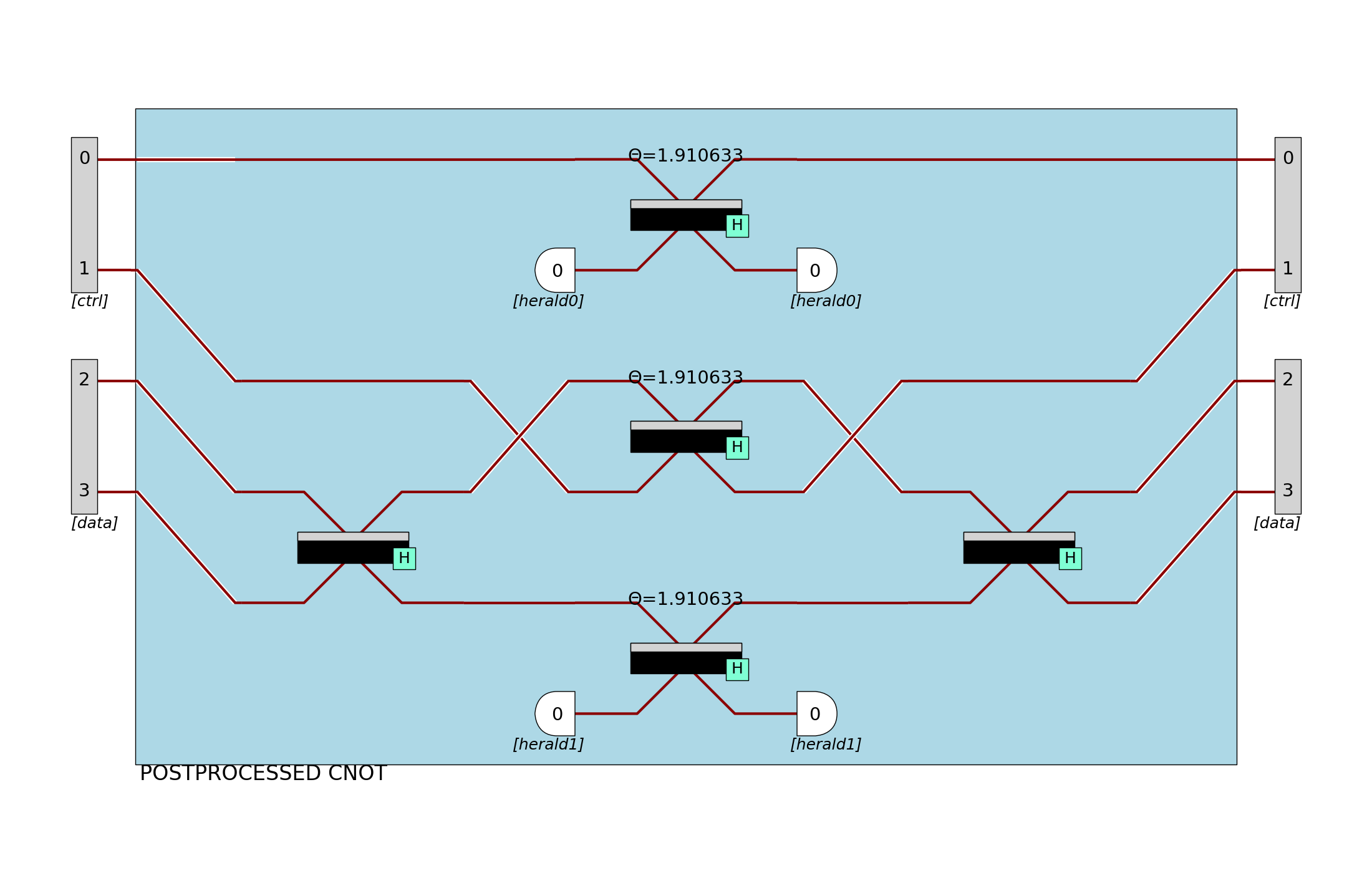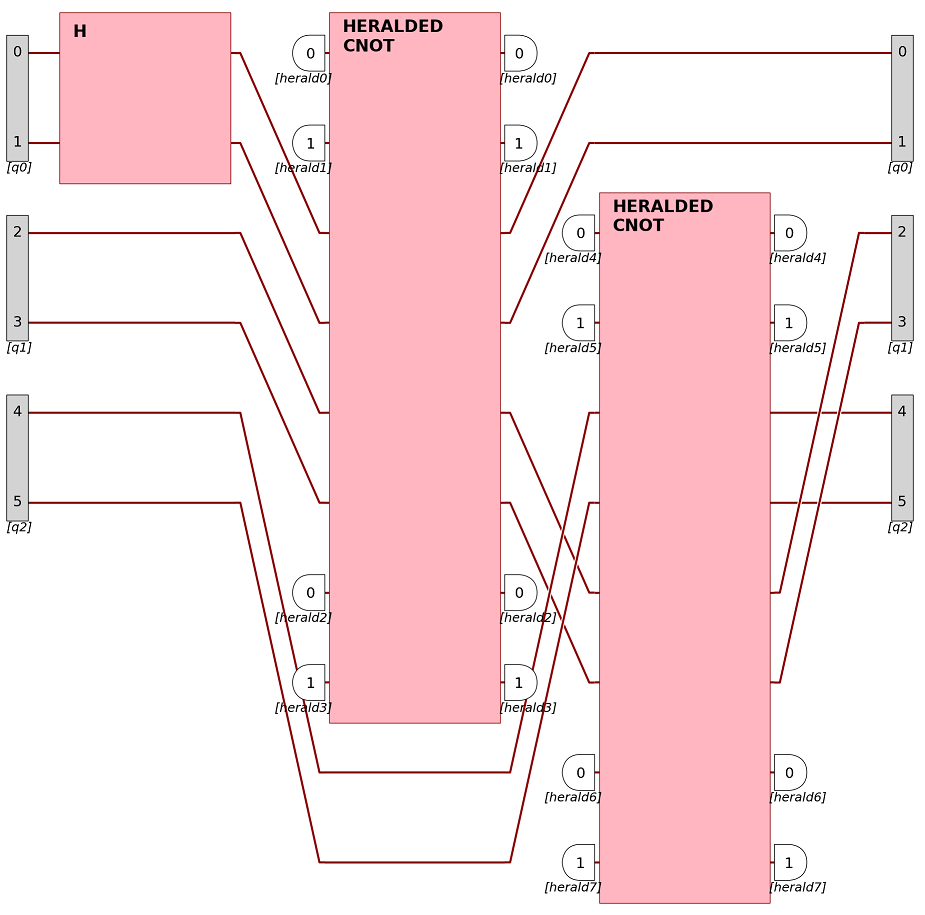You're reading the documentation of the v0.11. For the latest released version, please have a look at v1.1.
Run quantum algorithms
Perceval provides a processor-centric syntax to run an algorithm locally or remotely, on a simulator or an actual QPU.
Build a processor
A Processor is a composite element aiming at simulating an actual QPU, in real world conditions.
It holds a single photon Source
It is a composition of unitary circuits and non-unitary components
Input and output ports can be defined, with encoding semantics
Logical post-processing can be set-up through heralded modes (ancillas) and a final post-selection function
It contains the means of simulating the setup it describes with one of the provided Computing Backends
Create a local processor
To create a local processor, you just need to start with a Circuit, provide a backend name, and either an
optional Source or a NoiseModel with the following syntax:
>>> processor = pcvl.Processor("MY_BACKEND", my_circuit, source=my_source)
>>> processor = pcvl.Processor("MY_BACKEND", my_circuit, noise=my_noise_model)
If omitted, the source is a perfect single photon source.
The processor definition is then fine-tuned with ports (add_port) and herald (add_herald) definition as
in the following post-processed CNOT gate example:
>>> import perceval as pcvl
>>> from perceval.components import BS, PERM, Port
>>> from perceval.utils import Encoding
>>> theta_13 = BS.r_to_theta(1 / 3)
>>> c_cnot = (Circuit(6, name="PostProcessed CNOT")
... .add(0, PERM([0, 2, 3, 4, 1]))
... .add((0, 1), BS.H(theta_13))
... .add((3, 4), BS.H())
... .add((2, 3), PERM([1, 0]))
... .add((2, 3), BS.H(theta_13))
... .add((2, 3), PERM([1, 0]))
... .add((4, 5), BS.H(theta_13))
... .add((3, 4), BS.H())
... .add(1, PERM([3, 0, 1, 2])))
>>> processor_cnot = pcvl.Processor("SLOS", c_cnot)
>>> processor_cnot.add_port(0, Port(Encoding.DUAL_RAIL, 'ctrl')) \
... .add_port(2, Port(Encoding.DUAL_RAIL, 'data')) \
... .add_herald(4, 0) \
... .add_herald(5, 0)
>>> p.set_postselection(PostSelect("[0,1]==1 & [2,3]==1")) # Add a post-selection checking for a logical output state
>>> pcvl.pdisplay(processor_cnot, recursive=True)

Post-processed CNOT gate rendering - ancillary modes are not shown for readability
Processor composition
Processors can be composed with another processor. That is, for example, how the Qiskit converter outputs a complex preconfigured processor from a gate-based circuit.

A processor composed of a Hadamard gate and two heralded CNOT gates.
Remote processors
RemoteProcessor class is the entry point for sending a computation on a remote platform (a simulator or a QPU).
Quandela Cloud is a public cloud service with available QPUs and simulators.
An access token on the selected service is required to connect to a remote platform (e.g. an access token to Quandela
Cloud with rights is required to follow this tutorial: Remote computing on Quandela Cloud).
Once you have created a token suiting your needs (it needs to be given the rights to run jobs on target platforms), you may save it once and for all on your computer by running:
>>> pcvl.save_token('YOUR_TOKEN')
Note
We recommend you save your token only on a personal computer, not on shared/public ones.
A token value can also be set to every RemoteProcessor object
>>> remote_simulator = RemoteProcessor("platform:name", "YOUR_TOKEN")
For the rest of this page, let’s assume a token is saved in your environment.
A given remote platform is only able to support a specific set of commands. For instance, a real QPU is natively able to sample output detections, but not to compute probabilities of output states versus an input state. Hardware constraints might also enforce the coincidence counting type, or the type of detection (threshold detection or photon number resolving).
When creating a RemoteProcessor, you can query its capabilities
>>> remote_simulator = RemoteProcessor("qpu:altair")
>>> print(remote_simulator.available_commands)
['sample_count', 'samples']
This means sim:altair is only able to natively answer to sample_count and samples commands (i.e. return the results of a sample acquisition task).
Work with algorithms
All algorithms take either a local or a remote processor as parameter, in order to perform a task. A Processor
runs simulations on a local computer while a RemoteProcessor turns Perceval into the client of a remote service
such as Quandela Cloud, and the computation is performed remotely, on the selected platform.
However, for user experience, an algorithm has the same behavior be it run locally or remotely: every call to an
algorithm command returns a Job object, hiding this complexity.
>>> local_p = pcvl.Processor("CliffordClifford2017", pcvl.BS())
>>> local_p.with_input(pcvl.BasicState('|1,1>'))
>>> sampler = pcvl.algorithm.Sampler(local_p)
>>> local_sample_job = sampler.sample_count
Here, the computation has not started yet, but it’s been prepared in local_sample_job to run locally.
On a QPU, the acquisition is measured in shots. A shot is any coincidence with at least 1 detected photon. Shots act as credits on the Cloud services. Users have to set a maximum shots value they are willing to use for any given task.
>>> remote_p = pcvl.RemoteProcessor("sim:sampling")
>>> remote_p.set_circuit(pcvl.BS())
>>> remote_p.with_input(pcvl.BasicState('|1,1>'))
>>> sampler = pcvl.algorithm.Sampler(remote_p, max_shots_per_call=500_000)
>>> remote_sample_job = sampler.sample_count
Here, the computation was set-up to run on sim:sampling platform when remote_sample_job is executed.
For more information about the shots and shots/samples ratio estimate, please read Remote computing on Quandela Cloud.
Handle a Job object
Both LocalJob and RemoteJob share the same interface.
Execute a job synchronously
>>> args = [10_000] # for instance, the expected sample count
>>> results = job.execute_sync(*args) # Executes the job synchronously (blocks the execution until results are ready)
>>> results = job(*args) # Same as above
Execute a job asynchronously
>>> job.execute_async(*args)
This call is non-blocking, however results are not available when this line has finished executing. The job object provides information on the progress.
>>> while not job.is_complete: # Check if the job has finished running
... print(job.status.progress) # Progress is a float value between 0. and 1. representing a progress from 0 to 100%
... time.sleep(1)
>>> if job.is_failed: # Check if the job has failed
... print(job.status.stop_message) # If so, print the reason
>>> results = job.get_results() # Retrieve the results if any
Typically, the results returned by an algorithm is a Python dictionary containing a 'results' key, plus additional
data (performance scores, etc.).
A job cancellation can be requested programmatically by the user
>>> job.cancel() # Ask for job cancelation. The actual end of the execution may take some time
When a job is canceled, it may contain partial results. To retrieve them, call get_results().
A remote job can be resumed as following:
>>> remote_processor = pcvl.RemoteProcessor("any:platform")
>>> job = remote_processor.resume_job("job_id") # You can find job IDs on Quandela Cloud's website
>>> print(job.id) # The ID field is also available in every remote job object
Provided algorithms
Algorithms provided with Perceval are available in the Python package perceval.algorithm. They can perform as simple
tasks as the :code`Sampler`, or more complex computations. They’re all meant to be generic and versatile.
Sampler
The Sampler is the simplest algorithm provided, yet an important gateway to using processors.
All processors do not share the same capabilities. For instance, a QPU is able to sample, but not to sample output
probabilities given an input. The Sampler allows users to call any of the three main primitives on any
processor:
>>> sampler = pcvl.algorithm.Sampler(processor)
>>> samples = sampler.samples(10000) # Sampler exposes 'samples' primitive returning a list of ordered samples
>>> print(samples['results'])
[|0,1,0,1,0,0>, |0,1,0,0,1,0>, |0,2,0,0,0,0>, |0,0,0,1,0,0>, |0,1,0,1,0,0>, |0,1,0,1,0,0>, |0,1,1,0,0,0>, |0,1,0,1,0,0>, |0,1,1,0,0,0>, |0,1,0,1,0,0>, ... (size=10000)]
>>> sample_count = sampler.sample_count(10000) # Sampler exposes 'sample_count' returning a dictionary {state: count}
>>> prob_dist = sampler.probs() # Sampler exposes 'probs' returning a probability distribution of all possible output states
When a primitive is not available on a processor, a conversion occurs automatically after the computation is complete.
Batch jobs
The Sampler can setup a batch of different sampling tasks within a single job. Such a job enables you to gain
some time (overhead of job management) as well as tidy up your job list, especially when running on the Quandela Cloud
(but it can still be used in a local simulation context).
The system relies on defining a circuit containing variable parameters, then with each iteration of the batch job, you can set values for:
The circuit variable parameters - each iteration must define a value for all variable parameters so that the circuit is fully defined,
the input state,
the detected photons filter.
>>> c = BS() // PS(phi=pcvl.P("my_phase")) // BS() # Define a circuit containing "my_phase" variable
>>> processor = pcvl.RemoteProcessor("qpu:altair", token_qcloud)
>>> processor.set_circuit(c)
>>> sampler = Sampler(processor)
>>> sampler.add_iteration(circuit_params={"my_phase": 0.1},
>>> input_state=BasicState([1, 1]),
>>> min_detected_photons=1) # You can add a single iteration
>>> sampler.add_iteration_list([
>>> {"circuit_params": {"my_phase": i/2},
>>> "input_state": BasicState([1, 1]),
>>> "min_detected_photons": 1
>>> } for i in range(1, 6)
>>> ]) # Or you can add multiple iterations at once
>>> sample_count = sampler.sample_count(10000)
Note
As the same input state is used for all iterations, it could have been set once with
processor.with_input method and input_state removed from every iteration definition.
This job will iterate over all the sampling parameters in a batch and return all the results at once.
>>> results_list = sample_count["results_list"] # Note that all the results are stored in the "results_list" field
>>> for r in results_list:
>>> print(r["iteration"]['circuit_params']) # Iteration params are available along with the other result fields
>>> print(r["results"])
{'my_phase': 0.1}
{
|1,0>: 3735
|0,1>: 3828
|1,1>: 2437
}
{'my_phase': 0.5}
{
|1,0>: 4103
|0,1>: 3972
|1,1>: 1925
}
{'my_phase': 1.0}
{
|1,0>: 4650
|0,1>: 4607
|1,1>: 743
}
{'my_phase': 1.5}
{
|1,0>: 5028
|0,1>: 4959
|1,1>: 13
}
{'my_phase': 2.0}
{
|1,0>: 4760
|0,1>: 4788
|1,1>: 452
}
{'my_phase': 2.5}
{
|1,0>: 4155
|0,1>: 4252
|1,1>: 1593
}
Analyzer
The Analyzer algorithm aims at testing a processor, computing a probability table between input states and expected
outputs, a performance score and an error rate.
See usage in Ralph CNOT Gate